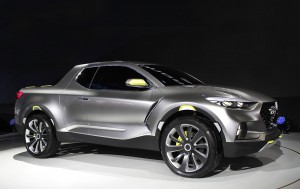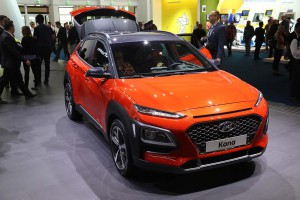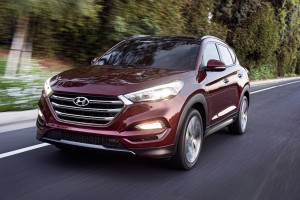
Hyundai won raves for the Santa Cruz concept, a car-based pickup, which it sorely needs in its U.S. line-up.
Slow to adapt to the shift from passenger cars to light trucks, Hyundai Motor Co. is racing to add new SUVs, as well as its first pickup truck, to its line-up, and it is giving serious consideration to producing them in its Alabama assembly plant.
Hyundai was one of the fastest-growing brands coming out of the American economic recession, but its growth has stalled over the last few years, analysts largely pointing to the Korean carmaker’s limited SUV options — the Santa Fe and the Tucson – at a time when light trucks account for nearly two-thirds of the American automotive market.
Hyundai officials have confirmed plans to expand the mix, with at least one, and likely two more SUVs coming. A version of the wildly popular Santa Cruz pickup is also nearing production and expected to be launched as early as the 2019 model-year.
The U.S. automotive market has been struggling this year, but Hyundai’s decline has been among the steepest for any manufacturer, sales during October alone down 15%, compared to the industry’s overall 1.2% dip. For the first 10 months of 2017, meanwhile, year-over-year sales were off about 16 percent.
At the same time, Hyundai’s two crossover-utility vehicles set all-time records for October, combined sales for the two models rising 12% for the month.
Before being ousted in a management shake-up earlier this year, former Hyundai Motor America CEO Dave Zuchowski indicated a range of new light truck models had gotten the go-ahead from corporate headquarters, including new SUVs, as well as the Santa Cruz project.
Hyundai reconfirmed that in August, announcing in a statement that, “Hyundai can confirm that the Santa Cruz concept has been greenlighted for development and is planned for the U.S. market.”
(For more on the Hyundai Santa Cruz plans, Click Here.)
First shown at the North American International Auto Show in Detroit in January 2015, the Santa Cruz isn’t aimed at directly competing with existing pickups. It is smaller and also based on a passenger car-like platform, rather than going body-on-frame. There are still a number of unanswered questions, such as whether it will get the unusual bed extender that was one of the concept version’s most popular features.
Meanwhile, the Hyundai statement stressed that “It’s still too soon to discuss market timing or further product details, but this innovative offering will be inspired by the well-received concept vehicle and bring a fresh utility vehicle interpretation to fit the lifestyles of a new generation of buyers.”
As for the SUV side, the automaker recently unveiled its Kona concept, and the B-segment model will go into production early in 2018. It’s designed to target other small utility vehicles like the Jeep Renegade, the Mazda CX-3 and even the quirky Soul model offered by sibling brand Kia.
“Even as the global SUV market is nearing saturation, we believe that extra small or small SUVs have more room for growth than large SUVs,” said Hyundai Motor Co Vice Chairman Chung Eui-sun said during the unveiling of the Kona in Seoul in June.
(Click Here for more on the Hyundai Kona.)
It appears likely that the Kona – and possibly the Santa Cruz – will initially be produced abroad and later shifted to the Hyundai assembly plant in Alabama. A report in the Seoul Economic Daily today said that move would occur by 2021. The plant, which currently builds the Sonata and Elantra sedans, as well as the Tucson, would expand its capacity by nearly 20%, the report said, from 380,000 to 450,000 vehicles annually.
Separately, Hyundai is reportedly considering what is being described by Australia’s “Motoring” as a “high-end performance truck.” But reports indicate there are currently no plans to bring it to the U.S.
Hyundai has not yet responded to a request for comment by TheDetroitBureau.com
(Hyundai quarterly profits take a hit. Click Here for more.)


